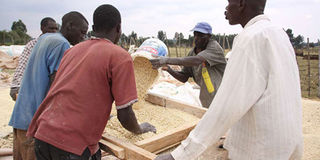Key steps in curbing aflatoxin in maize

Employees winnow dried maize in a farm. Maize is considered one of the best hosts of the aflatoxin-causing fungi and hence stored maize can accumulate toxins such as aflatoxin when not dried properly. NMG photo
What you need to know:
Aflatoxin is considered a carcinogen - something that is capable of causing cancer. The World Health Organisation (WHO) indicates the long-term effects of the toxin trigger cancer and cause immune deficiency. David Osogo, a nutrition and health researcher at Africa Population Health Research Center (APHRC), says aflatoxin contamination in the human body is linked to high risk of liver and kidney cancer, writes Eric Ogumo.
Aflatoxin is a fungal polyketide secondary metabolite caused by two main fungi; Aspergillus flavus and Aspergillus parasiticus, both of which produce four types of aflatoxins; aflatoxin B1, B2, G1 and G2. Aflatoxin B1 is the most common and can be carcinogenic if the toxicity level exceeds the set thresholds.
Maize is considered one of the best hosts of the fungi. I will highlight some of the opportunities that are readily available and can be useful in the overall management of aflatoxin;
Research and development
A lot of research has been done by Kenya Agricultural and Livestock Research Organisation (Kalro) and universities on aflatoxin. However, most of the findings never get to the farmers.
Kalro has successfully developed Aflasafe, a natural bio control product that reduces aflatoxin infestation in maize.
Aflasafe contains four atoxigenic Aspergillus flavus strain that outcompetes toxigenic strains of Aspergillus flavus when applied two to three weeks before flowering. The government recently commissioned an Aflasafe production plant at Kalro Katumani Station.
There has not been adequate farmers’ education on the benefits of using Aflasafe, which reduces incidence of aflatoxin by over 80 per cent.
Millers need to work with the universities and Kalro to support demand-driven research on aflatoxin. Lastly, plant breeders can contribute by developing varieties that are resistant to Aspergillus flavus.
Weather monitoring modules
It is well-known that Aspergillus flavus, the aflatoxin causing fungi, is prevalent in conditions of temperatures between 36°C to 38°C and humidity of above 85 per cent.
Scientists needs to use environmental data for the study of Aspergillus flavus to demonstrate the relationship between the fungus and the environmental variables and use this relationship to forecast the disease.
Pre-harvest stage
A lot of opportunities for managing aflatoxin exist at the pre-harvest level. Aspergillus flavus can survive in the soil and crop debris, thereby providing inoculum for the next crop.
There is need for adoption of Good Agricultural Practices (GAP) at the field level to ensure that inoculum level is reduced to the minimum by deep ploughing, removal of crop debris and crop rotation.
It is at this stage that farmers need to apply aflasafe three weeks before flowering.
Harvest stage
As a general rule, moisture content of the kernel is crucial in the management of aflatoxin. Maize should be harvested at moisture content level of below 15 per cent.
National Cereals and Produce Board (NCPB) and the millers must integrate their supply chain and get involved at the harvesting stage for quality control.
Storage at farm level
Most farmers usually store the harvested maize in bags piled up either on bare floor or levelled against the wall, resulting in dampness that encourages growth of Aspergillus flavus.
Most farmers store harvested maize for between three and six months, mainly in anticipation of better prices.
During storage period, farmers should check the moisture content of their produce and dry the kernels before selling it to the millers.
Eric Ogumo is the Chairman, Society of Crop Agribusiness Advisors (SOCAA).
What is aflatoxin and why should you care?
Aflatoxin is one of a group of naturally occurring poisonous substances, known as mycotoxins, produced by certain types of mould or fungi.
Aflatoxin is one of the most poisonous of the mycotoxins and has gained the most attention because of its occurrence in food and its severe effects on human health, according to the UN World Health Organisation (WHO).
The toxic fungi that produce it thrive in warm and moist environments, growing in soil, decaying vegetation, hay and grains.
WHO estimates that about 25 per cent of food produced globally is destroyed every year because of aflatoxin contamination - and there have been reports of Kenya destroying tonnes of maize for this reason.




